Forest Lawn Memorial Park (Glendale)
Forest Lawn Memorial Park is a privately owned cemetery in Glendale, California. It is the original and current flagship location of Forest Lawn Memorial-Parks & Mortuaries, a chain of six cemeteries and four additional mortuaries in Southern California.
.jpg.webp) Forest Lawn's Great Mausoleum | |
| Details | |
|---|---|
| Established | 1906 |
| Location | |
| Coordinates | 34.125°N 118.240°W |
| Type | Private |
| Owned by | Forest Lawn |
| Size | 300 acres |
| No. of graves | 250,000+ |
| No. of interments | 250,000+ |
| Website | www |
| Find a Grave | Forest Lawn Memorial Park |
History
Forest Lawn Memorial Park was founded in 1906 as a not-for-profit cemetery by a group of businessmen from San Francisco. Dr. Hubert Eaton and C. B. Sims entered into a sales contract with the cemetery in 1912, and Eaton took over its management in 1917. Although Eaton did not start Forest Lawn, he is credited as its "Founder" for his innovations of establishing the "memorial-park plan" (eliminating upright grave markers and bringing in works by established artists) and being the first to open a funeral home on dedicated cemetery grounds. He was a firm believer in a joyous life after death. Convinced that most cemeteries were "unsightly, depressing stoneyards", be pledged to create one that would reflect his optimistic Christian beliefs, "as unlike other cemeteries as sunshine is unlike darkness." He envisioned Forest Lawn as "a great park devoid of misshapen monuments and other signs of earthly death, but filled with towering trees, sweeping lawns, splashing fountains, beautiful statuary, and memorial architecture."[1] A number of plaques stating Eaton's intentions are signed "The Builder." Frederick Llewellyn, Eaton's nephew, became CEO of Forest Lawn in 1966. In 1987 he was succeeded by his son, John Llewellyn, the current chairman.[2]
Most of Forest Lawn's burial sections have evocative names, including Eventide, Babyland (for infants, shaped like a heart), Graceland, Inspiration Slope, Slumberland (for children and adolescents), Sweet Memories, Whispering Pines, Vesperland, Borderland (on the edge of the cemetery), and Dawn of Tomorrow.
Forest Lawn originally participated in racial segregation and "for decades refused entrance to blacks, Jews, and Chinese".[3]
Forest Lawn Museum
_-_Song_of_the_Angels_(1881).jpg.webp)
The Forest Lawn Museum in Glendale opened in 1952 and is next to the Hall of Crucifixion-Resurrection. It rotates art exhibitions twice yearly, and has hosted solo exhibitions for Henri Matisse, Winslow Homer, Ian Hornak, Francisco Goya, Rembrandt and Marc Davis. In 2021, it held an exhibition on Judson Studios,[4] the oldest family-run stained glass studio in the United States, which produced numerous stained glass windows for Forest Lawn in the Hall of Crucifixion-Resurrection and the Great Mausoleum.
Forest Lawn Museum's art collection consists primarily of original bronze and marble sculptures by European and American artists. The permanent collection also includes stained glass that used to be part of William Randolph Hearst's collection. Forest Lawn purchased the stained glass works in 1954. The windows date from c. 1315 to 1575, and display impressive examples of French, German, and Austrian craftsmanship in Gothic and Renaissance styles.
One of the most famous objects in the Forest Lawn Museum's permanent collection is by French artist William Bouguereau (1825-1905), who painted Song of the Angels in 1881. He studied at the Ecole des Beaux Arts in Paris, as well as in Rome, and was considered a leading French academic painter in the nineteenth century. In 2005, Song of the Angels was conserved[5] by the Chief Paint Conservator at the Getty Center[6], Mark Leonard. It is regarded as one of the most important examples of Bouguereau's work in the United States.
Another important work in the Forest Lawn Museum collection is a replica of Lorenzo Ghiberti's Gates of Paradise. The original doors, which are 17 feet tall and cast in bronze, are part of the Baptistery of St. John in Florence, Italy. Michelangelo is said to have exclaimed: "These doors are worthy to be the gates of Paradise!" The doors feature ten panels that start with creation and end with the visit of the Queen of Sheba to Jerusalem a millennia before the birth of Christ. They are meant to be from left to right, top to bottom. The Forest Lawn replica was cast by Professor Bruno Bearzi, who developed an innovative technique to reveal the gold on the centuries-old doors. He then made a cast of the doors for Forest Lawn. These doors, which are occasionally covered, are permanently installed in the Forest Lawn Museum galleries.
Statuary and art
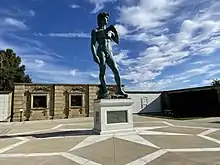
The six Forest Lawn cemeteries contain about 1,500 statues, about 10% of which are reproductions of famous works of art. Leonardo da Vinci's The Last Supper has been recreated in stained glass in the Memorial Court of Honor at the Glendale location 'in vibrant, glowing and indestructible colors'. There are also a number of full-sized reproductions of other Renaissance sculptures, including Michelangelo's David and Moses. This cemetery is the only place containing a complete collection of replica Michelangelo sculptures,[7] which were made from castings taken from the originals and use marble sourced from the original quarries in Carrara, Italy.
Some of the inspiration at Forest Lawn Glendale is patriotic rather than pious, such as the Court of Freedom, with its large mosaic of John Trumbull's Declaration of Independence and a 13-foot (4.0 m)-tall statue of George Washington. On display in the "Hall of the Crucifixion" is the panoramic painting by the Polish artist Jan Styka titled The Crucifixion. It is the largest permanently mounted religious painting in the world, measuring 195 feet (59 m) in length by 45 feet (14 m) in height. The main gates of Forest Lawn Glendale are claimed to be the world's largest wrought iron gates.[8]
Locations
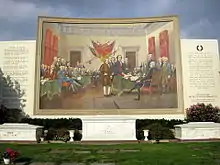
Forest Lawn Glendale has three non-denominational chapels: "The Little Church of the Flowers", "The Wee Kirk o' the Heather" and "The Church of the Recessional", which are all exact replicas of famous European churches. Over 60,000 people have been married here, including Ronald Reagan and Jane Wyman.
More than 335,000 people are buried at Forest Lawn Glendale, and over a million people visit it each year.
Forest Lawn's 300 acres (120 ha) of intensely landscaped grounds and thematic sculptures were the inspiration for the biting commentary of Evelyn Waugh's 1948 satirical novel The Loved One and Jessica Mitford's acerbic 1963 The American Way of Death. Many commentators have considered Forest Lawn to be a unique American creation, and perhaps a uniquely maudlin Los Angeles creation, with its "Disneyland-type theme park" approach to death.
Great Mausoleum
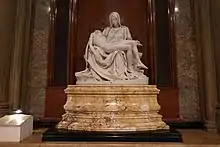
The Great Mausoleum features eleven terraces and over 100 stained glass windows. The massive building, which contains the same amount of steel and concrete as a 70-story skyscraper, embodies an eclectic mix of architectural styles, and is the park's artistic centerpiece.
The mausoleum's original architect was T. Paterson Ross. Numerous other people worked on it, and the construction designs underwent several rounds of changes. Construction began in 1917, and it was officially inaugurated in 1920. Construction finished only in the 1970s.
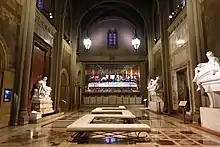
The Memorial Terrace was added in the late 1920s, and the Memorial Court of Honor was inaugurated in 1931. The gallery's largest piece is the Last Supper stained glass window by Rosa Caselli-Moretti and her sister, Cecilia Caselli- Moretti. This monumental project took over six years to complete. It was created in the sisters’ studio in Perugia, Italy, and shipped to Glendale, where it was formally dedicated on April 28, 1931. Commissioned expressly for the Memorial Court of Honor are the replicas of the seven Michelangelo sculptures including the Pietà. One of the mausoleum's last building phases incorporated French Gothic architecture with lofty ceilings and large stained-glass windows, creating an ethereal and tranquil space.
Churches at Forest Lawn
Wee Kirk o' the Heather
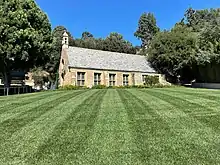
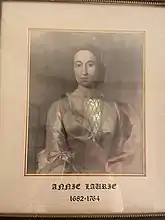
Wee Kirk o' the Heather is the second church built at Forest Lawn. The inspiration for the church was based on the village church (kirk) at Glencairn, Dumfriesshire, Scotland. This village church was erected in 1310 and subsequently destroyed in 1805. Dumfriesshire is rich in historical tradition, and it is most known for being where Sir Walter Scott wrote some of his most famous works, and former home of the famed poet, Robert Burns. The love song "Annie Laurie" is perhaps Scotland's most popular love ballad. It immortalizes the ill-fated romance of a woman that lived near the original "wee kirk" in the Glencairn.
The song was written by William Douglas of Fingland, a soldier in the Royal Scots Army. Annie Laurie was born at Maxwelton House in 1682, the daughter of Sir Robert Laurie, a baronet. Traditionally, it is believed that Annie's aristocratic family would not consent to her marrying an older soldier of an opposing clan.
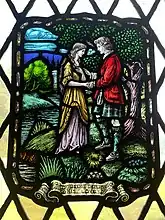
This evocative ballad is portrayed in eight beautiful stained glass windows along the south side of the Wee Kirk at Forest Lawn. Artifacts related to Annie including communion coins, will, and portrait are all housed in the historical room at the Wee Kirk. The Wee Kirk church was dedicated on October 6, 1929. Over five thousand people attended the ceremony, and Frank MacWilliams, Scottish tenor, sang "Annie Laurie."
In the forecourt of the Wee Kirk is a "Wishing Chair." Built in 1931, of stones from the original kirk at Glencairn, Scotland, legend has it that lovers who sit and speak the words inscribed on the chair will be forever blessed.
Little Church of the Flowers
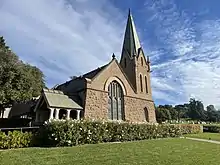
The Little Church of the Flowers was the first church to be built at Forest Lawn Memorial Park. The architect was T. Patterson Ross. Ross's inspiration was an English village church, Stoke Poges in Buckinghamshire, where the poet Thomas Gray had written "Elegy Written in a Country Churchyard," a famous English poem. Ross wanted to recreate the 600-plus-year-old parish church at Forest Lawn. He began his commission in 1917. The conservatories adjacent to the pews, filled with flowers, was added later on in the construction. The dedication ceremony took place on Mother's Day, May 12, 1918. At the end of the nave is a Tree of Life Window. The design of the window was created by a long-forgotten monk in an English Abbey; it was then translated into a stained glass medium.
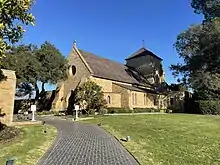
Church of the Recessional
The Church of the Recessional was the third church built at Forest Lawn. The architectural inspiration was the Church of St. Margaret in Rottingdean, Sussex, England, an Anglo-Saxon-styled stone and stained glass edifice dating from 1,100 A.D. that is still standing. The dedication ceremony took place on November 30, 1941. Within the chancel are three stained glass windows depicting scenes of the Virgin Mary and the Christ Child. The stained glass windows were produced by Charles J. Connick. Along both sides of the chancel arch, the pulpit and the baptismal font of St. Margaret's have been faithfully reprpduced. Over the arch are the words of Apostle Paul, "Now abideth faith, hope, and love, these three; and the greatest of these is love." Along the south side of the church are stained glass windows that depict the Beatitudes from the Sermon on the Mount.
In the forecourt of the church stands the romantic Ring of Aldyth, to which an Old Saxon legend attaches a prophecy of happiness and devotion for a couple who clasp their right hands through the ring and repeat together the inscribed vows: "Thy hand in mine, this ring doth bind, my heart to thine."
Notable interments
References
- Llewellyn, John F. (2018). Birth of a Cemetery: Forest Lawn Memorial-Park, Tropico Press, Glendale. ISBN 978-0966580174.
- Llewellyn, John F. (1998). A Cemetery Should Be Forever, p. xviii. Tropico Press, Glendale. ISBN 0966580125.
- Ehrenreich, Ben (1 November 2010). "The End". Los Angeles Magazine. Archived from the original on 22 July 2011. Retrieved 5 June 2011.CS1 maint: bot: original URL status unknown (link)
- Popescu, Adam (21 April 2021). "Stained Glass That Breaks All the Rules". The New York Times. ISSN 0362-4331. Retrieved 5 October 2021.
- "Adolphe-William Bouguereau's Virgin of the Angels (Getty Museum)". www.getty.edu. Retrieved 2021-12-14.
- "Adolphe-William Bouguereau: An Introduction (Visit the Getty)". www.getty.edu. Retrieved 2021-12-14.
- "Replicating Michelangelo – Smarthistory". smarthistory.org. Retrieved 2021-12-10.
- "Entrance Gates (Forest Lawn)". forestlawn.com. Archived from the original on 12 March 2016. Retrieved 11 March 2016.
External links
| Wikimedia Commons has media related to Forest Lawn Memorial Park, Glendale. |
- Official website
- Tribute to the founder of Forest Lawn Memorial-Parks by Charles Elias Disney
- https://pasadenaweekly.com/forest-lawn-museum-unveils-new-art-history-exhibition/
- https://angelusnews.com/voices/a-taste-of-california-gothic-at-forest-lawn-museum/